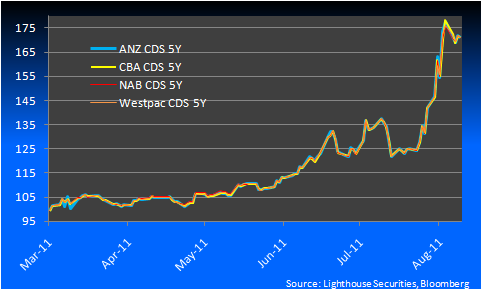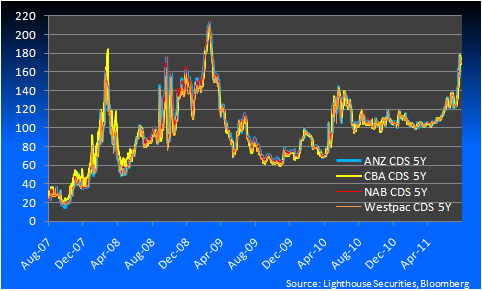Last Friday, the media was full of quotes from ANZ CEO Mike Smith about a coming crisis:
“Europe is frankly a mess, with quite genuine concerns about the solvency of countries such as Greece, Ireland and Portugal [and] the contagion effect that has on countries such as Italy and Spain,” he said in a conference call.
“In the US – which I’m normally much more optimistic about – we have seen a crisis which has been created by [the] partisan nature of its current politics and that’s created further concerns to what was already a pretty fragile recovery,” he said.
He said the massive volatility in equity and credit markets since the Standard & Poor’s downgrade of the US credit rating was clearly a signal that markets were concerned about softer growth in most advanced economies. It also reflected the lack of a clear plan from policy makers.
“It’s fair to say that right now this is all very delicately poised,” Mr Smith said.
“I think further missteps from European and US policymakers really risk converting the cracks in their economies into a much deeper global system crisis, which will have worrying social and economic consequences.
“Until that fundamentally gets sorted out we’re going to have more of this volatility,” he said.
Regular readers will know that I agree with these comments.
However, I am not the CEO of one of Australia’s big four banks. And comments coming from a man in such a position, even one with a reputation for candor, cannot be taken lightly, or necessarily, at face value. The comments have got me wondering if Mr Smith hasn’t begun a softening for a reactivation of the Australian government’s wholesale debt bank guarantee.
Are there other reasons to be thinking in these terms? Unfortunately, yes, there are. Take a look at the two charts of the big four’s CDS pricing:

That is a very worrying breakout and if we look at the longer term chart, we can see prices getting into nose-bleed territory:

We are, in fact, already into GFC levels of stress and at the same levels where the guarantee was implemented in 2008.
Now, CDS prices are not a perfect proxy for the bank’s underlying funding costs but they are the most liquid market pertaining to the bank’s wholesale funding and they are telling us that the stress is significant.
Recently we have seen the banks cut fixed interest mortgage rates, which the media has interpreted as evidence that the banks funding costs are falling. But they have also been slashing fixed interest deposit rates so there is no certainty at all that wholesale funding costs aren’t in fact rising.
Indeed, sources have revealed that during the most intense phase of the equity market selloff two weeks ago, on one particular day, the money markets that supply Australian banks with short term debt seized up, causing a mini credit crunch. Investors went to cash and cash only. It only lasted a day because of the equity bounce but it was an uncomfortable reminder of 2008.
As I’ve said before, CDS prices and funding sources will need to remain stressed for an extended period for a bailout to be needed but Mike Smith’s comments do not reassure and ongoing stress looks the order of the months ahead.

